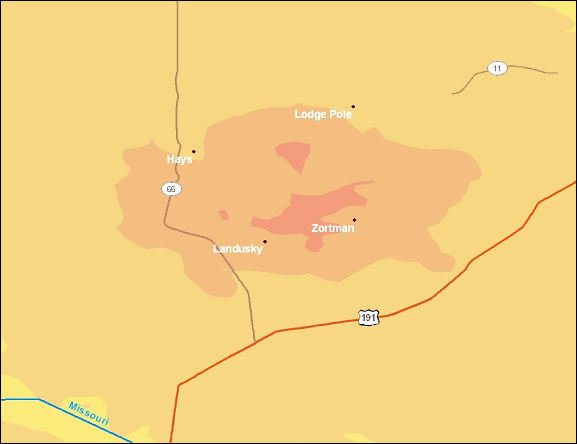Case Study as part of a Web-based
Technical and Regulatory Guidance
Zortman Landusky-Swift Gulch Site
Phillips County, Montana
1. Site Information
1.1 Contacts
Ionic Waters Technologies
Vance Weems
Telephone: 775-321-8101
Dr. Timothy Tsukamoto
Telephone: 775-321-8101
1.2
Name, Location, and Description
The Zortman Landusky mine is an inactive gold/silver mine located in the
Little Colorado Rockies north Central Montana (Figure 1-1). Swift Gulch contains
mining-impacted waters from a waste rock dump at the top of the drainage
(Ionic Waters Technologies, Inc. n.d.). The site is accessible seasonally,
and a mobile treatment system with a small footprint is required to provide
adequate remediation. The ownership includes patented mining claims on lands
administered by the U.S. Bureau of Land Management (BLM) located north of
the former permit area of the Landusky hard rock gold mine and east of the
boundary of the Fort Belknap Indian Reservation. The project is located in
Section 10 of T25N, R24E in Phillips County.

Figure 1-1. Zortman Mine location map. Created with ArcGIS Desktop Version 9.3.1
Swift Gulch flows into South Bighorn Creek approximately 2,200 ft upstream of the reservation boundary. South Bighorn flows westerly onto the reservation. Below the reservation boundary, this stream joins King Creek, then flows through the Pow Wow Grounds and numerous other recreational and camping sites within Mission Canyon before entering the town of Hays. Swift Gulch has been impacted by both historic and modern mining. Several adits were constructed within the watershed during the early 1900s. Placer dredge mining near the confluence of Swift Gulch with South Bighorn Creek during the 1930s disrupted the natural stream channel and floodplain. This activity left sections of the stream channelized, with much of the valley’s alluvial gravels piled in heaps adjacent to the stream. This disruption of the streambed causes some segments of the stream to disappear into the gravels under normal flow conditions for much of the year. Reclamation of the stream channel after placer mining was never performed.
Pegasus Gold Corporation (PGC) conducted open-pit mining within and adjacent to the headwaters of the watershed between 1985 and 1996. PGC declared bankruptcy in 1998, and the Montana Department of Environmental Quality (DEQ), in cooperation with the BLM, now operates the site’s water treatment systems using funds from short-term water treatment bonds that had been posted by PGC. Significant deterioration of water quality in Swift Gulch began in 1999 and may be in response to the deepening of portions of the Landusky pit adjacent to Swift Gulch, which occurred during 1995. Because water quality impairment in Swift Gulch became evident after the bankruptcy of PGC, no reclamation or water treatment bonds had been established to address conditions in that drainage.
Affected media include soil, sediment, surface water (e.g., stream, rivers, runoff, and drainage), surface pool water (e.g., lakes, ponds, and pools), and groundwater.
2. Remedial Action and Technologies
The primary impacts at the site, are from acidity, sulfate, and metals (aluminum,
arsenic, cadmium, iron, manganese, nickel, and zinc). Reclamation of the
site falls under the provisions of the Clean Water Act. Site cleanup goals
are based on the mitigation of human health risk and mitigation of ecological
risk.
The primary treatment technology in place at the site is chemical precipitation. The quantity of affected water being remediated is up to 60 gallons per minute, with the ability to treat all of the water in the drainage up to 300 gallons per minute. Chemical precipitation at the site includes lime neutralization and aeration and oxidation of reducing metals with the rotating-cylinder treatment system (RCTS) system. This system has been operating at full scale. Treatment began in August 2008 and is expected to continue indefinitely (on a seasonal basis).
3. Performance
Performance criteria that are applicable are under the Clean Water Act.
Performance criteria include measuring the contaminant concentrations in
water. The RCTS system was quickly mobilized, set up at the site, and operated
to treat flows in a remote area requiring a small footprint. The system operates
on less than 7.5 kw of power while providing near 100% lime utilization.
Titration studies show 30% less sludge is being produced when compared to
traditional methods. Operation and maintenance currently consist of lime
slurry mixing and instrument calibration. A more permanent installation would
likely decrease costs associated with monitoring the system.
4. Costs
Cost of activities at these site are reported as a total:
- Capital: less than $100,000 per year
- Operation and maintenance: less than $50,000 per year.
5. Regulatory Challenges
None encountered, since this was a pilot study.
6. Stakeholder Challenges
No information available.
7. Other Challenges and Lessons Learned
None reported.
8. References
Ionic Waters Technologies, Inc. n.d. “Montana Swift Gulch Project.”
